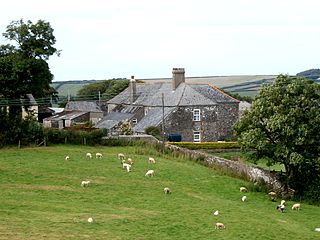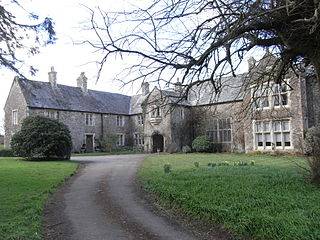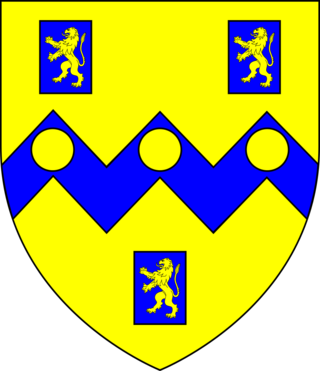
Orleigh is a historic manor in the parish of Buckland Brewer, situated 4 miles to the south west of Bideford, North Devon, England. The manor house is known as Orleigh Court. [1]

Orleigh is a historic manor in the parish of Buckland Brewer, situated 4 miles to the south west of Bideford, North Devon, England. The manor house is known as Orleigh Court. [1]
In the 10th century the manor of "Orlege" was one of the holdings of the Anglo-Saxon Ordwulf (died after 1005), son of Ordgar (d.971), Ealdorman of Devon under King Edgar (ruled 959-975). Ordgar planned for the founding of Tavistock Abbey in 961 which his son Ordwulf put into effect. [2] He held the manor by right of his wife Abina, and in 975 gave it as an endowment to Tavistock Abbey. Ordwulf's holding of Orleigh was recorded in an ancient cartulary of Tavistock Abbey, now lost, but quoted from by Dugdale (d.1686) in his Monasticon Anglicanum. [3]
The manor is not listed in Domesday Book of 1086, but may have been included for administrative purposes in the nearby manor of Abbotsham, [4] which is listed in Domesday Book, held also by Tavistock Abbey. Orleigh next appears in a charter of Pope Celestine III dated 1193 confirming it to the Abbey. [5]

The Denys family were for many centuries the feudal tenants of Orleigh under the overlordship of Tavistock Abbey until 1538, when the abbey was dissolved in the Dissolution of the Monasteries. They continued to hold it thereafter, under the overlordship of the Russell family, Earls of Bedford, who had acquired the abbey and its lands at the Dissolution. The descent of Denys of Orleigh is as follows: [7]
Anthony Dennis married twice:
In 1661 the three sisters conveyed jointly the manor of Orleigh to feoffees who sold it in 1684 to the Bideford tobacco merchant John I Davie (died 1710).

Charles Luxmore transferred Orleigh to Major Edward Lee (died 1819), whose heir was his infant nephew John Hanning. Hanning assumed the name Lee, as he was required to do under his uncle's will, and purchased as his residence Dillington Manor near Ilminster in Somerset. He let Orleigh to his brother-in-law William Speke of Jordans near Ilminster, Somerset. Speke had seven children, all but one daughter having been born at Orleigh, including his eldest son the famous explorer and discoverer of the source of the River Nile, John Hanning Speke (1827–1864).
The Speke family gave up their tenancy of Orleigh in 1845 and Mr Lee next let the house to Col. Bayly from 1845 to 1856 and then to Capt. Audley Mervyn-Archdale from 1856 to 1869. In 1869 he sold Orleigh to Thomas Rogers, [22] whose descendant was W.H. Rogers, M.A., F.S.A., the historian of Orleigh and Buckland Brewer, who published his work "Buckland Brewer" in 1938.

Watermouth Castle is a building in Watermouth, near Ilfracombe, North Devon, England, designed by George Wightwick as a residence for the Bassett family in the mid-19th century and is not a true castle but a country house built to resemble one. It has been designated as a Grade II* listed building.

Halsbury is a historic manor in the parish of Parkham in North Devon, England. It is situated 2 miles north-east of the village of Parkham and 4 miles south-west of the town of Bideford. Halsbury was long a seat of the ancient Giffard family, a distant descendant of which was the celebrated lawyer Hardinge Stanley Giffard, 1st Earl of Halsbury (1823–1921), who adopted the name Halsbury for his earldom and was the author of the essential legal reference books Halsbury's Statutes. Halsbury Barton, now a farmhouse, retains 16th- and 17th-century elements of the former manor house of the Giffard family. It was described in a record of 1560 as a "new dwelling house".

Sir John Basset, of Tehidy in Cornwall and of Umberleigh in Devon was Sheriff of Cornwall in 1497, 1517 and 1522 and Sheriff of Devon in 1524. Although himself an important figure in the West Country gentry, he is chiefly remembered for his connection with the life of his second wife and widow Honor Grenville, who moved into the highest society when she remarried to Arthur Plantagenet, 1st Viscount Lisle KG, an illegitimate son of King Edward IV, and an important figure at the court of King Henry VIII, his nephew.

Charles Henry Williams of Pilton House and Westaway House, Pilton, near Barnstaple, and of Watermouth Castle all in North Devon, was a British naval and military officer, JP and Deputy Lieutenant for Devon, and a Conservative Party politician. He was a Member of Parliament (MP) for Barnstaple, 1868–1874. He was master of the Devon and Somerset Staghounds between 1887 and 1893.

Orleigh Court is a late medieval manor house in the parish of Buckland Brewer about 4 miles south-west of Bideford, North Devon, England. It is a two-storeyed building constructed from local slate stone and has a great hall with a hammer-beam roof, installed in the late 15th century.

John Davie (1640–1710) of Orleigh Court in the parish of Buckland Brewer, Devon, England, was a prominent tobacco merchant from Bideford, Devon. His Bideford town house which he built in 1688, was Colonial House, now the Royal Hotel, in which survive several 17th-century decorative plasterwork ceilings, said by Pevsner & Cherry (2004) to be amongst the best in Devon, and a grand staircase.

Tapeley is a historic estate in the parish of Westleigh in North Devon, England.

Sir Francis Drake, 3rd Baronet (1642–1718), of Buckland Abbey in the parish of Buckland Monachorum and of Meavy, both in Devon, England, was elected seven times as a Member of Parliament for Tavistock in Devon, in 1673, 1679, 1681, 1689, 1690, 1696 and 1698.
The surname Denys was borne by at least three prominent mediaeval families seated in Gloucestershire, Somerset and Devon in southwest England between 1166 and 1641. It is not known if any relationship existed between these families. The surname Denys is just one of many variant spellings of the name: Denise, Le Deneis, Le Danies, le Deneys ,and most recently Dennis, are some of the others.

George Rolle of Stevenstone in the parish of St Giles in the Wood near Great Torrington in Devon, was the founder of the wealthy, influential and widespread Rolle family of Devon, which according to the Return of Owners of Land, 1873 in the person of Hon. Mark Rolle, the adoptive heir of John Rolle, 1st Baron Rolle, had become by that year the largest landowner in Devon with about 55,000 acres. He was a Dorset-born London lawyer who in 1507 became Keeper of the Records of the Court of Common Pleas and was elected as a Member of Parliament for Barnstaple in 1542 and 1545. He became the steward of Dunkeswell Abbey in Devon, and following the Dissolution of the Monasteries he purchased much ex-monastic land in Devon. Not only was he the founder of his own great Devonshire landowning dynasty but he was also an ancestor of others almost as great, including the Acland baronets of Killerton, the Wrey Baronets of Tawstock and the Trefusis family of Trefusis in Cornwall now of Heanton Satchville, Huish, later Baron Clinton, heirs both of Rolle of Heanton Satchville, Petrockstowe and of Rolle of Stevenstone.

Hall is a large estate within the parish and former manor of Bishop's Tawton, Devon. It was for several centuries the seat of a younger branch of the prominent and ancient North Devon family of Chichester of Raleigh, near Barnstaple. The mansion house is situated about 2 miles south-east of the village of Bishop's Tawton and 4 miles south-east of Barnstaple, and sits on a south facing slope of the valley of the River Taw, overlooking the river towards the village of Atherington. The house and about 2,500 acres of surrounding land continues today to be owned and occupied by descendants, via a female line, of the Chichester family. The present Grade II* listed neo-Jacobean house was built by Robert Chichester between 1844 and 1847 and replaced an earlier building. Near the house to the south at the crossroads of Herner the Chichester family erected in the 1880s a private chapel of ease which contains mediaeval woodwork saved from the demolished Old Guildhall in Barnstaple.
The Feudal Barony of Berry Pomeroy was one of eight feudal baronies in Devonshire, England, which existed during the mediaeval era. It had its caput at the manor of Berry Pomeroy, 20 miles south of the City of Exeter and 2 miles east of the town of Totnes, where was situated Totnes Castle, the caput of the feudal barony of Totnes. The exact location of the 11th-century baron's residence is unclear; perhaps it was next to the parish church on the site of the former rectory known as Berry House, as it is now believed that the nearby ruined Berry Pomeroy Castle was not built until the 15th century.

Annery was an historic estate in the parish of Monkleigh, North Devon.
East Hagginton was a historic estate within the manor and parish of Berrynarbor near to the coast of North Devon. It is near to, if not actually encompassing, the site of Watermouth Castle.
The manor of Bideford in North Devon was held by the Grenville family between the 12th and 18th centuries. The full descent is as follows:

Philip Beaumont (1432–1473), lord of the manors of Shirwell in North Devon and of Gittisham in East Devon, was a member of parliament for a constituency in Devon and was Sheriff of Devon in 1469. He was the rightful heir of his elder brother William Beaumont (1427–1453), a substantial landholder, but faced claims to his inheritance from his bastard nephew, John Bodrugan, "The Beaumont Bastard", the illegitimate son of Joan Courtenay, William's wife.

Upcott is an historic manor in the parish of Cheriton Fitzpaine, Devon. The manor house, known as Upcott Barton is a mediaeval grade II* listed building notorious in the history of Devon as the place where in 1455 the murder of the lawyer Nicholas Radford by a mob directed by the Earl of Devon during the Wars of the Roses took place. In the grounds is a reproduction of an Iron Age roundhouse built circa 2014.

Canonteign is an historic tything in the parish of Christow, near Chudleigh, in South Devon, England and situated in the valley of the River Teign. The 'canon' in the name refers to the Augustinian canons regular, either of St Mary du Val in Normandy or of Merton Priory, which owned it for several centuries. It is best known today for the Canonteign Falls waterfall. Canonteign today contains three significant houses: the original Grade I listed 16th-century manor house, the ancient barton house situated nearby behind a granite wall, and a new mansion house built by the Pellew family in the early 19th century nearby, to which that family moved their residence thereby abandoning the old manor house.

Sir Christopher Harris of Radford in the parish of Plymstock in Devon, was a Member of Parliament for Plymouth in Devon in 1584. He was knighted in 1607. He should not be confused with his great-nephew and heir apparent Christopher Harris (d.1623) of Lanrest in the parish of Liskeard in Cornwall, a Member of Parliament for West Looe in Cornwall (1621).

Spridleston is an historic manor in the parish of Brixton in Devon, England, long a seat of a branch of the prominent and widespread Fortescue family. The ancient manor house does not survive, but it is believed to have occupied the site of the present Spriddlestone Barton, a small Georgian stuccoed house a few hundred yards from the larger Spriddlestone House, also a Georgian stuccoed house, both centred on the hamlet of Spriddlestone and near Higher Spriddlestone Farm.